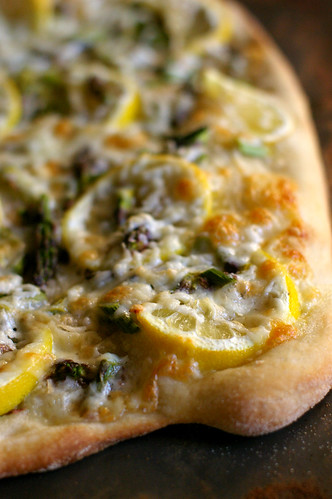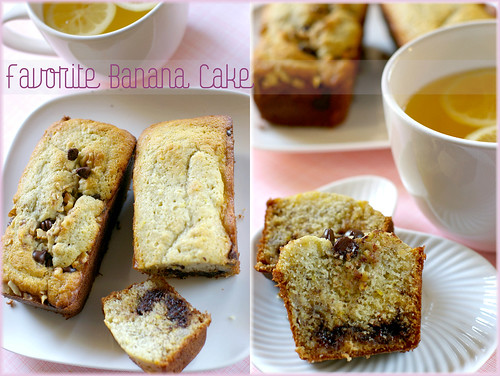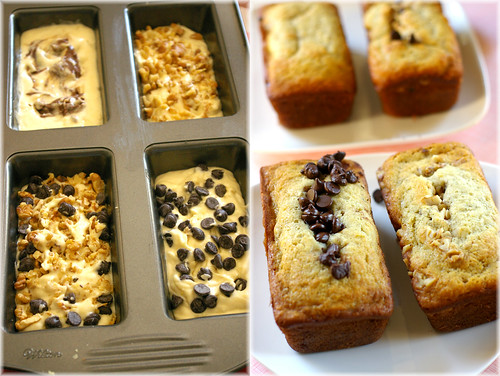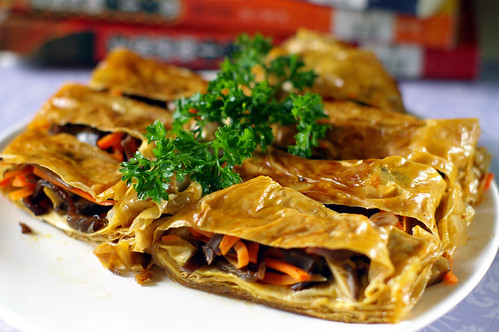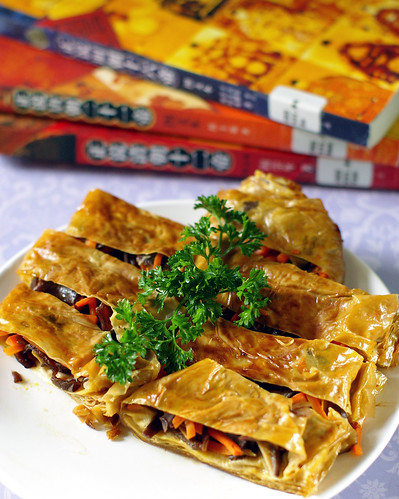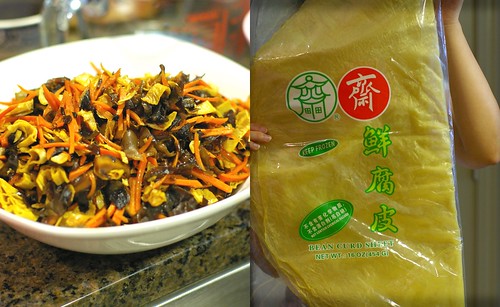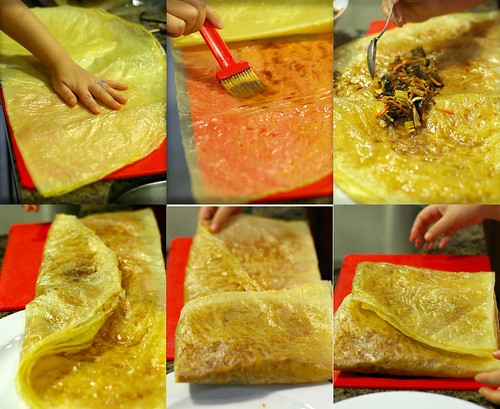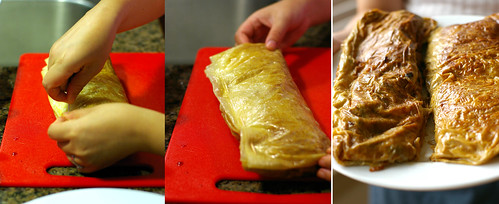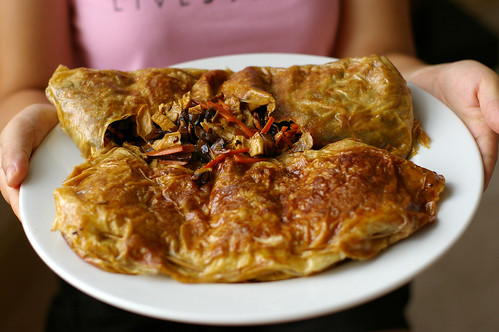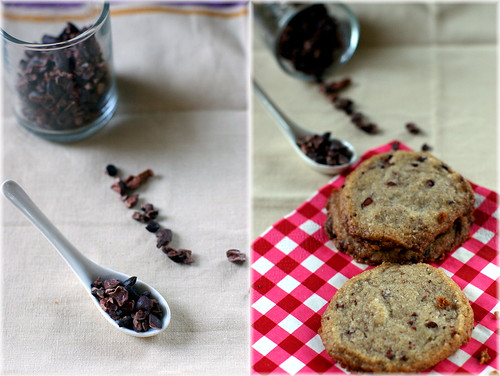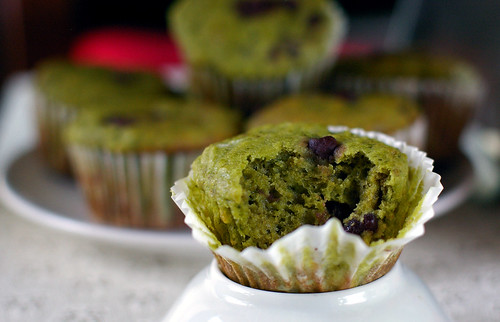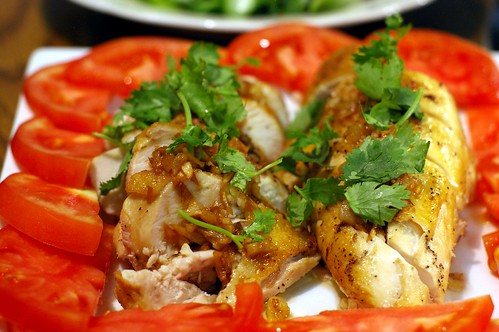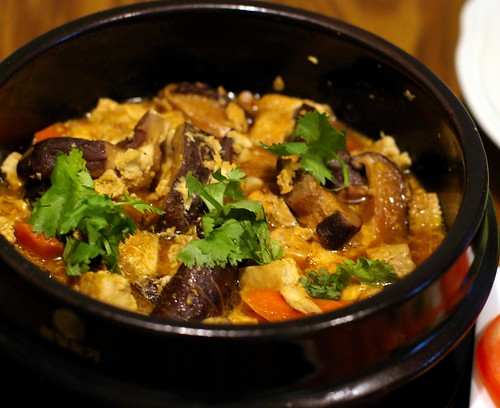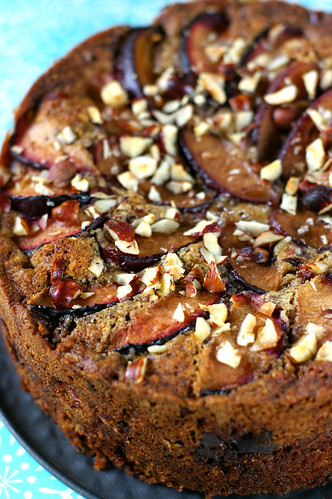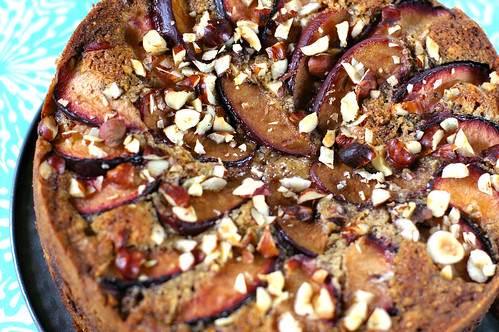(seafood pizza, lemon asparagus pizza, caramelized onion, mushroom and triple cheese pizza)
It's the time of the month again! Pizza is chosen as the October Daring Bakers Challenge, by our hostess Rosa's Yummy Yums. When the challenge was first revealed, I thought it was going to be a piece of cake. Why, I have made a few pizzas before, it's not the most complicated thing to make, if working with yeast doesn't intimidate you.
As I read on, I realize that, as part of the challenge, we have to attempt tossing the dough, and capture the moment. That would indeed be a challenge.
Unlike the pizza recipes I have worked with before, this recipe from Peter Reinhart takes 2 days. I am intrigued by the different in texture and taste developed from the prolong fermentation/resting. I must say that it's one of the best pizza crust I have made.
I don't have a pizza stone, so I simply use the back of the cookie sheet. The crust still turns out crisp. Instead of cornmeal, I use kamut flour, which I can't find other use after making a batch of kamut shortbread. Other than that, I follow the recipe provided.
I make 3 pizzas from half a batch of pizza dough- Seafood Pizza, Lemon Asparagus Pizza and Caramelized Onion & Mushroom with Triple Cheese Pizza. As expected, the Seafood Pizza turned out to be the crowd pleaser. But the lemon asparagus pizza, which toppings idea I adopted from Elizabeth Falkner on foodandwine.com is surprisingly delightful.
The three pizzas are what's for dinner tonight, and that makes me a very happy girl! Thanks Rosa's Yummy Yums for selecting this recipe as our October challenge. I am glad to have another great pizza dough recipe under my belt now. I can totally foresee myself making it again soon for brunch or lunch party, as my friend T not so discreetly hinted.
I tried the tossing method, a skill I really want to master, but just couldn't get it right yet. :( I am going to try that again when I shape the remaining dough.
Check out other mouth-watering pizza creations from my fellow Daring Bakers here.
Basic Pizza Dough
“The Bread Baker's Apprentice: Mastering The Art of Extraordinary Bread” by Peter Reinhart
Makes 6 pizza crusts (about 9-12 inches/23-30 cm in diameter).
Ingredients:
4 1/2 Cups (20 1/4 ounces/607.5 g) Unbleached high-gluten (%14) bread flour or all purpose flour, chilled - FOR GF: 4 ½ cups GF Flour Blend with xanthan gum or 1 cup brown rice flour, 1 cup corn flour, 1 cup oat flour, 1 ½ cup arrowroot, potato or tapioca starch + 2 tsp xanthan or guar gum
1 3/4 Tsp Salt
1 Tsp Instant yeast - FOR GF use 2 tsp
1/4 Cup (2 ounces/60g) Olive oil or vegetable oil (both optional, but it’s better with)
1 3/4 Cups (14 ounces/420g or 420ml) Water, ice cold (40° F/4.5° C)
1 Tb sugar - FOR GF use agave syrup
Semolina/durum flour or cornmeal for dusting
DAY ONE
Method:
1. Mix together the flour, salt and instant yeast in a big bowl (or in the bowl of your stand mixer).
2. Add the oil, sugar and cold water and mix well (with the help of a large wooden spoon or with the paddle attachment, on low speed) in order to form a sticky ball of dough. On a clean surface, knead for about 5-7 minutes, until the dough is smooth and the ingredients are homogeneously distributed. If it is too wet, add a little flour (not too much, though) and if it is too dry add 1 or 2 teaspoons extra water.
NOTE: If you are using an electric mixer, switch to the dough hook and mix on medium speed for the same amount of time.The dough should clear the sides of the bowl but stick to the bottom of the bowl. If the dough is too wet, sprinkle in a little more flour, so that it clears the sides. If, on the contrary, it clears the bottom of the bowl, dribble in a teaspoon or two of cold water.
The finished dough should be springy, elastic, and sticky, not just tacky, and register 50°-55° F/10°-13° C.
Or
2. FOR GF: Add the oil, sugar or agave syrup and cold water, then mix well (with the help of a large wooden spoon or with the paddle attachment, on low speed) in order to form a sticky ball of dough.
3. Flour a work surface or counter. Line a jelly pan with baking paper/parchment. Lightly oil the paper.
4. With the help of a metal or plastic dough scraper, cut the dough into 6 equal pieces (or larger if you want to make larger pizzas).
NOTE: To avoid the dough from sticking to the scraper, dip the scraper into water between cuts.
5. Sprinkle some flour over the dough. Make sure your hands are dry and then flour them. Gently round each piece into a ball.
NOTE: If the dough sticks to your hands, then dip your hands into the flour again.
6. Transfer the dough balls to the lined jelly pan and mist them generously with spray oil. Slip the pan into plastic bag or enclose in plastic food wrap.
7. Put the pan into the refrigerator and let the dough rest overnight or for up to thee days.
NOTE: You can store the dough balls in a zippered freezer bag if you want to save some of the dough for any future baking. In that case, pour some oil(a few tablespooons only) in a medium bowl and dip each dough ball into the oil, so that it is completely covered in oil. Then put each ball into a separate bag. Store the bags in the freezer for no longer than 3 months. The day before you plan to make pizza, remember to transfer the dough balls from the freezer to the refrigerator.
DAY TWO
8. On the day you plan to eat pizza, exactly 2 hours before you make it, remove the desired number of dough balls from the refrigerator. Dust the counter with flour and spray lightly with oil. Place the dough balls on a floured surface and sprinkle them with flour. Dust your hands with flour and delicately press the dough into disks about 1/2 inch/1.3 cm thick and 5 inches/12.7 cm in diameter. Sprinkle with flour and mist with oil. Loosely cover the dough rounds with plastic wrap and then allow to rest for 2 hours.
Or
8. FOR GF: On the day you plan to eat pizza, exactly 2 hours before you make it, remove the number of desired dough balls from the refrigerator. Place on a sheet of parchment paper and sprinkle with a gluten free flour. Delicately press the dough into disks about ½ inch/1.3 cm thick and 5 inches/12.7 cm in diameter. Sprinkle the dough with flour, mist it again with spray oil. Lightly cover the dough round with a sheet of parchment paper and allow to rest for 2 hours.
9. At least 45 minutes before making the pizza, place a baking stone on the lower third of the oven. Preheat the oven as hot as possible (500° F/260° C).
NOTE: If you do not have a baking stone, then use the back of a jelly pan. Do not preheat the pan.
10. Generously sprinkle the back of a jelly pan with semolina/durum flour or cornmeal. Flour your hands (palms, backs and knuckles). Take 1 piece of dough by lifting it with a pastry scraper. Lay the dough across your fists in a very delicate way and carefully stretch it by bouncing it in a circular motion on your hands, and by giving it a little stretch with each bounce. Once the dough has expanded outward, move to a full toss.
Or
10. FOR GF: Press the dough into the shape you want (about 9-12 inches/23-30 cm in diameter - for a 6 ounces/180g piece of dough).
NOTE: Make only one pizza at a time.
During the tossing process, if the dough tends to stick to your hands, lay it down on the floured counter and reflour your hands, then continue the tossing and shaping.
In case you would be having trouble tossing the dough or if the dough never wants to expand and always springs back, let it rest for approximately 5-20 minutes in order for the gluten to relax fully,then try again.
You can also resort to using a rolling pin, although it isn’t as effective as the toss method.
11. When the dough has the shape you want (about 9-12 inches/23-30 cm in diameter - for a 6 ounces/180g piece of dough), place it on the back of the jelly pan, making sure there is enough semolina/durum flour or cornmeal to allow it to slide and not stick to the pan.
Or
11. FOR GF: Lightly top it with sweet or savory toppings of your choice.
12. Lightly top it with sweet or savory toppings of your choice.
Or
12. FOR GF: Place the garnished pizza on the parchment paper onto the stone in the oven or bake directly on the jelly pan. Close the door and bake for about 5-8 minutes.
NOTE: Remember that the best pizzas are topped not too generously. No more than 3 or 4 toppings (including sauce and cheese) are sufficient.
13. Slide the garnished pizza onto the stone in the oven or bake directly on the jelly pan. Close the door and bake for abour 5-8 minutes.
Or
13. FOR GF: Follow the notes for this step.
NOTE: After 2 minutes baking, take a peek. For an even baking, rotate 180°.
If the top gets done before the bottom, you will need to move the stone or jelly pane to a lower shelf before the next round. On the contrary, if the bottom crisps before the cheese caramelizes, then you will need to raise the stone or jelly.
14. Take the pizza out of the oven and transfer it to a cutting board or your plate. In order to allow the cheese to set a little, wait 3-5 minutes before slicing or serving.
To make Seafood Pizza
Toppings: 8 medium shrimps, 1/2 cup squids and 1/4 cup crab meat, cooked and cooled. parmesan cheese, provolone cheese.
Sauce: Smoked Salmon Cream cheese spread, leftover from my local bagel shop.
To make Caramelized Onion, Mushroom and Triple Cheese Pizza
topping: Caramelized onion, see instruction here; sauteed mushroom, brie, parmesan, provolone cheese.
sauce: marinara sauce
To make Lemon Asparagus Pizza:
topping: 1/2 pound of asparagus, cut into 1/4 inch piece on a diagonal, provolone cheese, parmesan cheese, 1 lemon, preferably meyer lemon, sliced thinly.
sauce: none. just brush the top of the dough with extra virgin olive oil.
Read more...









